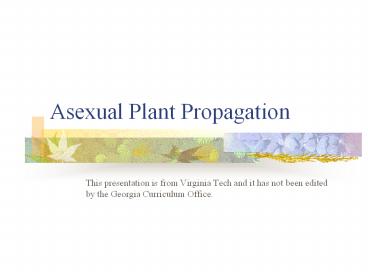Asexual Plant Propagation PowerPoint PPT Presentation
1 / 20
Title: Asexual Plant Propagation
1
Asexual Plant Propagation
- This presentation is from Virginia Tech and it
has not been edited by the Georgia Curriculum
Office.
2
Plant Propagation
- The reproduction of new plants from seeds or
vegetative parts of a plant.
3
Asexual Propagation
- The reproduction of new plants from the stems,
leaves, or roots of a parent plant. - No seeds are used, just portions of the parent
plant which are placed in soil
4
Benefits of Asexual Propagation
- Produce plants faster
- Disease free stock
- Works when seeds are hard to germinate
- Plants produced are genetically identical to the
parent plant Clones - Plants with or without reproductive parts can be
produced - Less Expensive in some cases
5
Where Can Cuttings be Taken From?
- Roots
- Stems
- Leaves
6
Methods of Asexual Propagation
- Stem Cuttings
- Leaf Cuttings
- Leaf Bud Cuttings
- Root Cuttings
7
Stem Cuttings
- Softwood Cuttings
- Herbaceous Cuttings
- Semi-hardwood Cuttings
- Hardwood Cuttings
- Conifer Cuttings
- See Figure 1 on handout
8
Softwood Cuttings
- Taken from soft, new spring growth of woody
plants - Root easy but require more attention
- Usually 3 to 5 inches in length
- 2 or 3 nodes
- Cut at 45 degree angles ¼ inch below a node
- 1/3 of lower leaves are removed
9
Herbaceous Cuttings
- Also considered softwood cuttings
- Numerous succulent greenhouse plants
- 3 to 4 inches long
- Contain several leaves
- Root easily
10
Semi-hardwood Cuttings
- Woody, broad leaved plants
- Taken in the summer from new shoots
- 3 to 6 inches in length
- Handled the same as softwood cuttings
11
Hardwood Cuttings
- Prepared during the dormant season
- Deciduous or evergreen plants
- 6 to 8 inches in length
- Taken from year old wood
- Form callus tissue during the winter
- Develop roots in the spring
12
Conifer Cuttings
- Early winter
- Narrowleaf evergreens
- May take several months to produce roots
13
Leaf Cuttings
- Consist of a leaf blade or leaf blade with
petiole - Used when plant material is scarce
- Used when a large number of new plants are needed
- Houseplants or foliage plants
14
Leaf Cuttings Cont.
- Leaf blades can be cut into pieces and inserted
into medium - See Figure 2 in handout
- Some leaves can be cut on the primary veins and
laid flat on top of the growing medium. - See Figure 3 in handout
- Leaf and petiole cuttings are place petiole down
the the medium - See Figure 4 in handout
15
Leaf Bud Cuttings
- Consist of a leaf, petiole, and a short piece of
stem with lateral bud. - Must have well developed buds, and healthy,
actively growing leaves. - Insert in medium with the lateral bud just below
the surface - See Figure 5 in handout
16
Root Cuttings
- Made from root pieces of young plants
- During late winter or early spring
- Roots are dug, cleaned, and treated with
fungicide - 2 to 6 inches in length
- Placed horizontally or vertically
- Quite laborious
17
Rooting Hormones
- Material that promote the development of roots
- Applied to the bases of the cuttings
- Powders or Solutions
- Do not use too much, it may cause the stem to rot
18
Root-Inducing Environment
- High humidity to reduce water loss
- Indirect sunlight
- Growing medium
19
Types of Growing Medium
- Peat moss perlite mixture
- 1 to 1 ratio will hold moisture and provide
aeration - Vermiculite
- Sterile and has high moisture retention
- Sand
- Provides aeration but does not retain moisture
- Sand peat moss mixture
- 1 to 1 or 2 to 1 ratio, increases moisture
retention
20
Summary
- Asexual propagation is the propagation of plants
from stems, leaves, or roots of a parent plant - Cuttings are the most popular form
- Cuttings are often treated with a rooting hormone
- The environment is very important for successful
rooting

